“Innovation is the most abused word in the English language.” That’s how Vijay Vaitheeswaran, the US business editor for The Economist kicked off their Innovation Summit, held in Chicago in March.
What Vaitheeswaran meant by the provocative statement was that innovation is often viewed through an overly narrow lens. It’s equated to patents or to specific technologies. While important, Vaitheeswaran argued, these are only inputs to innovation. They’re inventions. And, while we are indeed living in a great age of invention, it’s only part of the answer.
Rather, Vaitheeswaran defines innovation as “fresh thinking that creates value.” Invention often plays a role. But the hard part is using judgment to extract value from fresh ideas.
We see innovation in this form playing out throughout the technology landscape. Some tech companies are indeed primarily defined by their technological achievements. (Though, even in the case of a company like Google, it was also arguably defined by finding a way to create a business model out of its original search tech.)
When we talk about innovation being delivered from within upstream open source communities, we tend to focus on the code itself. But that innovation is also about a development model that allows for novel forms of collaboration and communication. And the sustainability of open source depends a great deal on the companies creating products from those upstream projects and building profitable business models around them.
[ Get The Open Organization Workbook, a free download with advice from more than 25 experts on building transparent, collaborative organizations. ]
This general theme played out throughout the event across a number of different areas of business and technology.
Doing open partnerships well
Beth Devin, Head of innovation network and emerging technology at Citi Ventures highlighted how partnerships and relationships among companies and universities have become the norm. “The days of walled gardens are gone,” she said. In fact, she highlighted how one of the challenges of blockchain is the integration across use cases. In other words, breaking down walls and silos is important but it’s also hard.
[ Read also: Blockchain in action: 5 interesting examples. ]
But figuring out how we open things up and share is often not straightforward. Vaitheeswaran asked: “How do we do open well? What’s the right balance?” For example, while crowdsourcing can be effective, it can also produce everything from “fake news” to the dreck one often finds in YouTube comments sections. “There’s stupidity as well as a maddening mediocrity of crowds,” Vaitheeswaran argued.
Analytics opportunities and challenges
The broad use and sharing of data has its own specific challenges relating to the use of that data in AI and other types of analytics.
Using data for business advantage was clearly of interest to the audience at the event. One polling question asked them about which digital competencies were most important to them. Number one was “analytics using customer and/or operational data” at 46 percent. (By contrast, IT infrastructure modernization – a more traditional company technology concern – only polled at 11 percent.)
However, analytics aren’t about shoving data in one end and getting business value out the other.
As Nicole Eagan, CEO at Darktrace, noted: “You can’t just automate analytics that weren’t being effective in the first place.” Furthermore people have to trust what the computer is telling them. For example, in the context of using AI for security, she said that “if the security team doesn’t trust AI, they won’t use it.”
[ Can AI really solve that problem? Read also: How to identify an AI opportunity: 5 questions to ask. ]
Another discussion brought up the tension between tracking and analytics that promote productivity and those that cross the line into creepiness. For example, close tracking of Amazon warehouse workers to deter theft can be seen as dehumanizing. But what if it eliminates or reduces the need for searches by security guards?
Ultimately, as Gary Shapiro, President and chief executive of the Consumer Technology Association (CTA), put it “Everything we’ve talked about today is just a tool – for good or bad.” He added that there are even “different nation to nation cultural differences.” We’re seeing this reflected, for example, in the increasingly sharp divisions between the US and Europe on certain aspects of privacy as seen in the GDPR and “right to be forgotten” regulations. And culture can evolve. Shapiro reminded the audience that it was once “considered immoral to do commerce on the Internet.”
New ideas, new risks
How do we reign in risk more broadly? Another panel asked: “As beneficial as new technologies are, they come with serious associative risks. What are they and what are we doing about them? From misinformation to AI ethics and data privacy, how well prepared are society and business to mitigate these risks?”
Dan Wagner, founder and CEO of Civis Analytics, focused on the tradeoff between privacy and utility and argued that the propagation of bias in AI is a people problem, not an algorithm problem. Humans are needed to assess the correctness of datasets and the way they’re being used, he said.
However, Renee DiResta, trust fellow at Mozilla, highlighted how certain behaviors are probably inherent in using algorithms for some purposes. “Once you signal to an algorithm that you’re interested in getting more of it. It’s all over the Internet, not just Facebook.” She added that “techlash is creating more awareness of it” but it’s not clear what the best “disinfectant” is.
None of these problems are going away. There are more devices, more tracking. There’s more value to business and more value to government. Alex Gladstein, Chief strategy officer of the Human Rights Foundation, described how tracking systems are “more Kafka-esque than Orwellian in China right now. It doesn’t work very well. But they want it to work well.” The question we need to answer is “Are these devices going to be liberation tools or tracking devices?”
[ Are you leading toward a more innovative culture? Get the free eBook, Organize for Innovation, by Jim Whitehurst. ]






